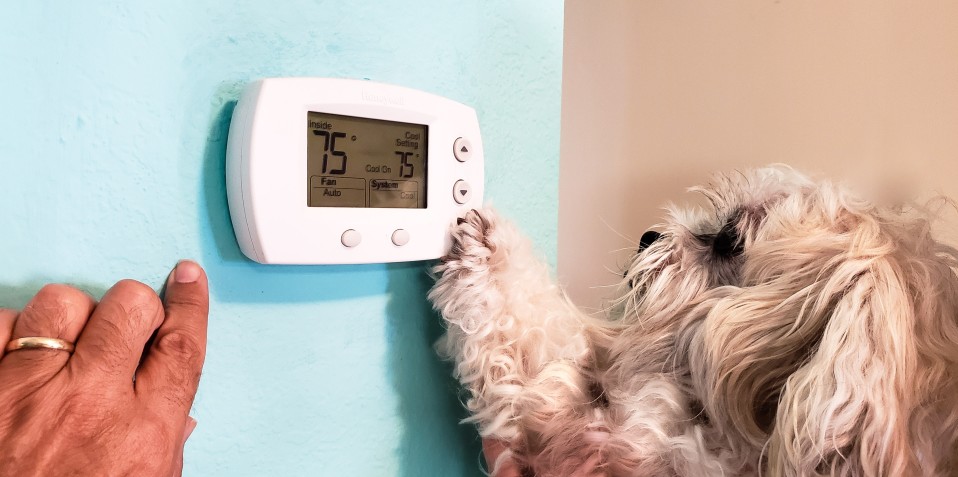Winter is coming, and with it, lower temperatures and higher heat bills. When cranking up the thermostat you may notice an emergency or auxiliary setting and wonder what it does or when it should be used. Before flipping the switch, there are a few things you should know about your HVAC system’s emergency heat settings that can save you a headache (and money) down the road. These six important tips should get you through the chilly days ahead.
1. Emergency Heat Is for Emergencies Only
Just as the name implies, the emergency heat or auxiliary setting on your HVAC system should only be used in case of an emergency, not when you’re a little chilly and want your home to heat up faster. Under normal winter conditions, your system’s main heat pump shouldn’t have any issues keeping your home at a comfortable temperature. But if the temperatures plummet to an extreme low, your furnace may struggle to keep up. During an extended extreme cold spell, our primary heat pump may even quit working all-together. This is when your emergency heat system can be a life saver—literally! Hit the emergency heat setting to kick on your backup heat pump, which can be sourced by electricity, gas, oil, or even your hot water back up system. This should provide enough warmth to get your by until your HVAC technician can repair your main system.
2. Your HVAC System May Not Have An Emergency Heat Setting
Depending on where you live, your system may not have an emergency setting at all. In southern climates where temperatures rarely fall below freezing, it’s common to see HVAC systems without this setting. This can be a problem during an exceptionally cold spell, which has becoming more and more common. Keep this fact in mind if you plan to upgrade your furnace or HVAC in the future. You may need to specifically ask for a unit set up to handle emergency heat situations.
3. Using Your Emergency Heat Setting May Cause a Spike in Your Utility Bill
Switching your system over to the emergency heat or auxiliary setting means your furnace has already been working as hard as it can, lowering its eficiency. Switching it over to emergency heat is always more expensive, so you will likely see an additional spike in your utility bill during that time period. For this reason, you should use your emergency heat setting for the shortest time possible. If you call your HVAC service provider and they advise you to turn on your emergency heat, know that they aren’t trying to run up your electric bill—they want to make sure your family and home stay warm until they can send a technician out to service your HVAC unit.
4. Check Your Heating System Functions Before Switching to Emergency Heat
Before switching on your emergency heat, check your HVAC system for damage or strain. If your heat has been struggling for a few days, make sure your outdoor unit is functioning properly. Winter storm damage such as fallen tree limbs and debris could be the culprit, as well as a frozen unit from a water leak. If everything looks fine but your furnace is still struggling, it may be a result of an extended time period of cold weather that even the most efficient unit can’t keep up with. As soon as you decide to activate your emergency heat, but sure to contact your HVAC technician to service your unit.
5. If Your Emergency Heat Indicator is On, It Means One of Two Things
There are only two reasons your emergency or auxiliary heat indicator light is illuminated. One, and the best case scenario, is because you turned your emergency heat on. This indicator light remains on during the time that your emergency heat pump is on. However, if you did NOT turn on your emergency heat and the indicator is lit up, there could be a problem with your main heat pump. This is often how your HVAC system lets you know if there is an issue when it detects a problem. If the latter happens, immediately contact your HVAC technician for assistance.
6. Check Your Emergency Heat Setting Before You Need It
There is nothing worse than switching your emergency heat setting on, only to discover it’s not working. Never assume because you’ve never had to use it, that it will function normally when you need it. Checking the emergency settings on your HVAC unit should be part of normal routine maintenance. Most homeowners are capable of doing minor seasonal maintenance but having an annual (or more often) inspection by an HVAC professional is the key to having a warm home and family this winter.
City Heating & Air Conditioning—Keeping You Warm and Safe This Winter
Over the last several years, we’ve seen Knoxville winter temperatures dip below freezing for extended periods of time. And for over 50 years, Knoxville residents and businesses have trusted City Heating & Air for honest, dependable service, snow or sun. Along with no-hassle annual inspections and maintenance plans, we offer 24/7 emergency services, no matter the weather.
Will we have another winter to rival the blizzard of ’93? Maybe not, but let us help you be prepared just in case! Contact us today at 865-938-1005 or email us at [email protected] for a free quote or to schedule your service before Old Man Winter comes knocking.

